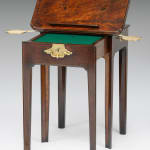George III Mahogany Artist's Table
IRELAND, CIRCA 1770
73.5 x 58.5 x 40 cm
29 x 23 x 15 ¾ in
29 x 23 x 15 ¾ in
623a/7108
Further images
-
(View a larger image of thumbnail 1
)

-
(View a larger image of thumbnail 2
)

-
(View a larger image of thumbnail 3
)

-
(View a larger image of thumbnail 4
)

-
(View a larger image of thumbnail 5
)

-
(View a larger image of thumbnail 6
)

-
(View a larger image of thumbnail 7
)

-
(View a larger image of thumbnail 8
)

-
(View a larger image of thumbnail 9
)

-
(View a larger image of thumbnail 10
)

-
(View a larger image of thumbnail 11
)

-
(View a larger image of thumbnail 12
)

Provenance
Thomas St Lawrence, 1st Earl of Howth (1730–1801), at Howth Castle, Co. Dublin,Thence by descent in the Gaisford St. Lawrence family at St. Dominick St., Dublin
Of unusually small proportions. The adjustable rectangular moulded top with re-entrant corners and (replacement) detachable book rest. The raised top supported by curved brass arms with locking screws. The pull-out...
Of unusually small proportions. The adjustable rectangular moulded top with re-entrant corners and (replacement) detachable book rest. The raised top supported by curved brass arms with locking screws. The pull-out base with writing slide, well drawer with compartments and pull-out pen and ink drawer. Complete with a bold, shaped brass escutcheon and handle to the front and brass candle arms. Raised on tapering chamfered legs.
Howth Castle was home to the same family since the 12th century. According to legend, Sir Almeric Tristram took possession of Howth in 1177 and adopted the name of St. Lawrence, having won the battle at Evora Bridge on his feast day - 10th August. The Lawrence family fortune and influence grew, peaking in the 18th century.
Howth Castle was home to the same family since the 12th century. According to legend, Sir Almeric Tristram took possession of Howth in 1177 and adopted the name of St. Lawrence, having won the battle at Evora Bridge on his feast day - 10th August. The Lawrence family fortune and influence grew, peaking in the 18th century.
The first edition of Chippendale’s Director from 1754 included drawing chests/tables with ratcheted tops. In ‘The Life and Work of Thomas Chippendale’, (1978) Christopher Gilbert illustrates a related design by Chippendale for an artist’s table dating from circa 1760 (pl. 397, p. 218). In 'The Universal System of Household Furniture' by Ince & Mayhew such pieces are described more broadly as ‘writing and reading tables.’












